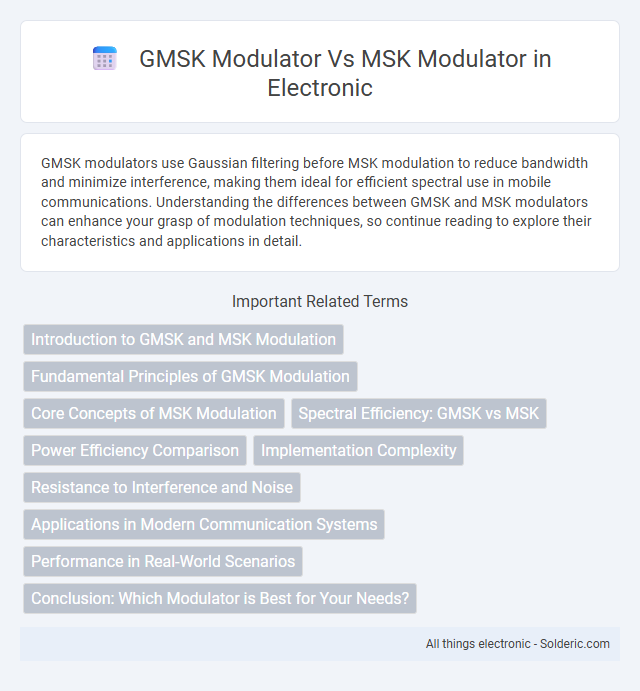GMSK modulators use Gaussian filtering before MSK modulation to reduce bandwidth and minimize interference, making them ideal for efficient spectral use in mobile communications. Understanding the differences between GMSK and MSK modulators can enhance your grasp of modulation techniques, so continue reading to explore their characteristics and applications in detail.
Comparison Table
| Feature | GMSK Modulator | MSK Modulator |
|---|---|---|
| Full Name | Gaussian Minimum Shift Keying | Minimum Shift Keying |
| Pulse Shaping | Gaussian filter applied | Rectangular pulse |
| Bandwidth Efficiency | High (bandwidth compressed) | Moderate |
| Phase Continuity | Continuous phase | Continuous phase |
| Spectral Efficiency | Better due to Gaussian filtering | Less efficient compared to GMSK |
| Inter-Symbol Interference (ISI) | Reduced by Gaussian filtering | Minimal but higher than GMSK |
| Complexity | More complex modulation and demodulation | Simpler implementation |
| Common Usage | GSM cellular systems, Bluetooth (basic rate) | Satellite communications, some wireless standards |
| Error Performance | Similar to MSK, slightly better in noisy channels | Good error performance, slightly lower than GMSK |
| Power Efficiency | High power efficiency | High power efficiency |
Introduction to GMSK and MSK Modulation
GMSK (Gaussian Minimum Shift Keying) and MSK (Minimum Shift Keying) are digital modulation schemes widely used in wireless communications for efficient spectrum usage. GMSK applies a Gaussian filter to smooth the phase transitions, reducing sideband power and interference, while MSK modulates data using continuous phase frequency shifts with minimal frequency deviation. Your choice between GMSK and MSK modulators impacts spectral efficiency and complexity, with GMSK being popular in GSM cellular networks and MSK favored for its constant envelope and low error rates in continuous phase modulation systems.
Fundamental Principles of GMSK Modulation
GMSK modulation is a form of continuous-phase frequency shift keying that uses Gaussian filtering to smooth the phase transitions of the signal, reducing spectral side lobes and interference. Unlike MSK modulation, which directly shifts the frequency between two orthogonal states representing binary data, GMSK introduces controlled phase continuity, enhancing bandwidth efficiency and minimizing intersymbol interference. Your communication system benefits from GMSK's ability to provide robust signal integrity and improved spectral efficiency in mobile and wireless applications.
Core Concepts of MSK Modulation
MSK modulation employs continuous phase frequency shift keying with a modulation index of 0.5, ensuring minimum frequency shifts for constant envelope signals and spectral efficiency. The GMSK modulator extends MSK by applying a Gaussian filter to smooth phase transitions, reducing sideband power and enhancing bandwidth efficiency. Both modulators maintain phase continuity, but MSK's core concept emphasizes orthogonal signal representation with minimal inter-symbol interference for reliable wireless communication.
Spectral Efficiency: GMSK vs MSK
GMSK modulator offers higher spectral efficiency compared to MSK modulator due to its continuous phase modulation and Gaussian filtering, which reduces sideband power and limits bandwidth expansion. MSK modulator, while maintaining a constant envelope like GMSK, has a rectangular pulse shaping that results in wider spectral occupancy. For your communication system, choosing GMSK can improve bandwidth utilization and minimize interference in spectrally congested environments.
Power Efficiency Comparison
GMSK modulators exhibit higher power efficiency compared to MSK modulators due to their constant envelope property, which enables the use of non-linear power amplifiers with lower back-off, reducing power consumption. MSK modulators, while offering good spectral efficiency and low complexity, require linear amplification to preserve signal integrity, resulting in increased power consumption. This makes GMSK modulation particularly advantageous in battery-powered wireless communication systems where power efficiency is critical.
Implementation Complexity
GMSK modulators exhibit higher implementation complexity compared to MSK modulators due to the need for Gaussian filtering before frequency modulation, which requires precise filter design and additional processing resources. MSK modulators benefit from simpler implementation by directly modulating the phase with constant envelope signals, resulting in lower computational and hardware demands. Your choice between these modulators should consider trade-offs between spectral efficiency and system complexity based on application requirements.
Resistance to Interference and Noise
GMSK modulators provide higher resistance to interference and noise due to their continuous phase modulation and Gaussian filtering, which reduces signal bandwidth and minimizes sideband power. MSK modulators also offer good noise performance through constant envelope modulation but lack the spectral efficiency of GMSK, making them more susceptible to adjacent channel interference in congested environments. Your choice between GMSK and MSK modulation impacts system robustness, with GMSK generally favored for enhancing performance in noisy wireless communication channels.
Applications in Modern Communication Systems
GMSK modulators are widely used in GSM cellular networks and Bluetooth technology due to their spectral efficiency and reduced out-of-band emissions, which minimize interference in crowded frequency bands. MSK modulators find applications in military communication systems and satellite links where constant envelope modulation is essential for nonlinear amplifier compatibility and improved signal robustness. Both modulation schemes support reliable wireless communication, but GMSK's lower bandwidth requirements make it the preferred choice in mobile telephony and IoT devices.
Performance in Real-World Scenarios
GMSK modulators offer improved spectral efficiency and enhanced resistance to nonlinear distortions, making them suitable for mobile communication systems like GSM that require robust performance under varying channel conditions. MSK modulators provide constant envelope signals with minimal phase discontinuities, resulting in low out-of-band emissions and better performance in multipath environments often encountered in wireless channels. In real-world scenarios, GMSK's controlled phase transitions give it a slight edge in bandwidth efficiency, while MSK's simpler implementation and inherent robustness favor applications requiring minimal signal distortion.
Conclusion: Which Modulator is Best for Your Needs?
GMSK modulators offer better spectral efficiency and reduced sideband emissions, making them ideal for mobile communications requiring bandwidth conservation and low interference. MSK modulators provide simpler implementation with constant envelope properties suitable for basic digital systems where robustness is key. Your choice depends on whether you prioritize spectral efficiency (GMSK) or implementation simplicity and robustness (MSK) in your communication system.
GMSK modulator vs MSK modulator Infographic

 solderic.com
solderic.com